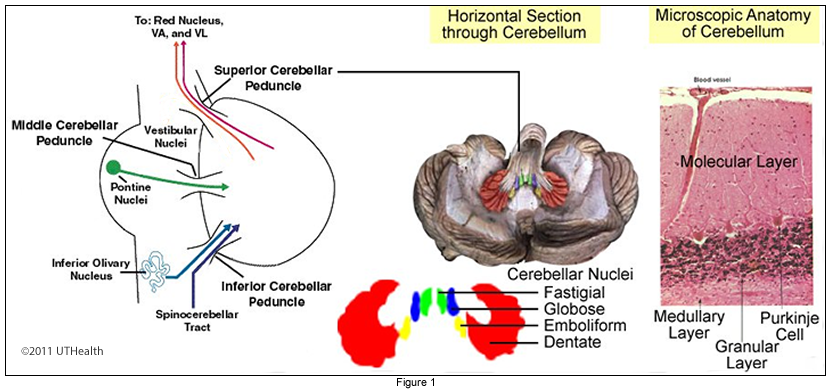Lab 5 (ƒ8) - Higher Motor Function
Cerebellum
The cerebellum is thought to be important for the motor learning, by making movements more adaptive via inputs that encode when movements have incorrect consequences. Although the lateral parts of the cerebellum have generally been thought to participate in the planning of movements, modern functional imaging studies suggest that the lateral cerebellum may also contribute to certain cognitive functions.
Throughout the cerebellar cortex, two fiber types provide input: 1. Mossy fibers (of widely varied origin) and 2. Climbing fibers which originate in the contralateral inferior olive. The mossy fibers bring input from several sources including the spinal cord and brainstem reticular formation (via the ICP) and the pontine nuclei via the MCP. The mossy fibers synapse with cerebellar granule cells and Golgi cell interneurons. The climbing fibers send axons to synapse directly on the Purkinje cells via the ICP.
Whereas mossy fibers convey sensory and motor command information to the cerebellum, the climbing fibers are believed to be important in conveying movement errors and in inducing long lasting changes in cerebellar synapses, resulting in motor learning.
Purkinje cells of the cerebellar cortex send their exclusively inhibitory projections to the deep cerebellar nuclei. Those located in parts of the vermis and flocculonodular lobe also send axons directly to the vestibular nuclei. The cerebellar nuclei send their axons to the red nucleus and the VL nucleus of the thalamus.
Two small nuclei, the emboliform and globose nuclei are located medial to the dentate nucleus (which resembles the inferior olivary complex) They are collectively referred to as the interposed nucleus because they are located between the dentate nucleus and the most medially located fastigial nucleus.


